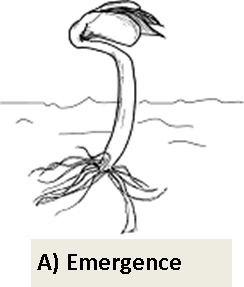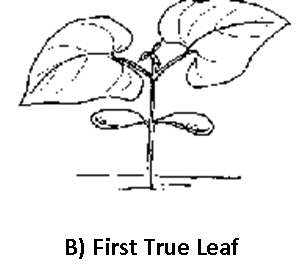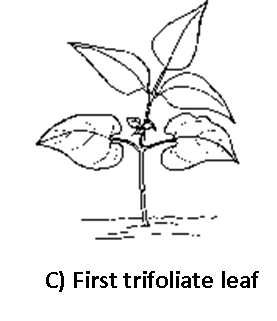Snap Beans

Growing Snap Beans
Varieties
Fresh Market
Green
Jade, Bronco, Ambra, Savannah, Caprice, Sahara, Valentino.
Yellow Wax
Goldrush, Unidor, Rocdor, HM5101
Process Market
Consult processors, HM5101
See your seed dealer for the most recent variety recommendations.
Seed Treatment
Purchase fungicide treated seed if possible, otherwise treat seed with Thiram or Captan seed protectants, according to manufacturers’ directions.
For suppression of seedborne diseases including common blight (Xanthomanos axonopodis pv. phaseoli), halo blight (Pseudomonas syringae pv.phaseolicola) and bacterial brown spot (Pseudomonas syringae pv. syringae), use seed treated with Kocide 2000-0.
For control of Pythium damping off, use seed treated with Apron XL LS seed protectant. For control of damping off caused by Pythium spp., Fusarium spp. and Rhizoctonia spp.; and for seedling blight caused by Pythium spp., use seed treated with Apron MAXX RTA.
For control of seed corn maggot and wireworm, use seed treated with Cruiser 5FS.
Soil Temperature
Good germination is obtained at soil temperatures of 16 to 29°C. Seed rot is a serious problem at lower temperatures.
Seeding and Spacing
Always handle bean seed with care, as rough handling lowers the percentage of germination.
For bush beans, seed 10 to 16 seeds/50 cm of row 50 to 90 cm apart or as required for a particular mechanical harvester. Losses due to gray and white mold are greatest at close spacing. Aim for a final plant stand of 300,000 plants per hectare (12,000/acre). This is usually 75 to 100 kg/ha (30 to 40 kg/acre) of seed depending upon seed size and germination percentage.
For pole beans, seed 7 to 10 seeds/50 cm of row and space rows 1.65 m apart.
Sow at a uniform depth of 4 cm if pre-emergence herbicides are to be used.
Fertilizer
A soil test is necessary to determine phosphate and potash requirements. Use the Vegetable Production Guide: Nutrient Management (PDF) for recommendations based on soil test results.
Lime should be applied if the pH is below 5.6 on mineral soils.
Bush Beans
Broadcast and disc in required potash prior to seeding. At time of seeding, band 15 to 40 kg/ha (6 to 16 kg/acre) of nitrogen and all the required phosphate 5 cm to the side of the seed, and 7.5 to 10 cm deep.
Pole Beans
Broadcast and disc in the required potash. At time of seeding band 70 kg/ha (28 kg/ acre) of nitrogen and all the phosphate 5 cm to the side of the seed and 7.5 to 10 cm deep. Just prior to blossoming, side-dress with 40 kg/ha (16 kg/acre) of nitrogen.
Magnesium may be required on light soils.
Bean Leaf Stages



Snap Bean Weed Management
Pre-plant Incorporation
| Product | Rate | PHI* | Comments |
|---|---|---|---|
Eptam 8-E(EPTC)Group 15 |
4.25 to 5.5 L/ha (1.7 to 2.2 L/acre) |
N/A |
|
Bonanza 480(trifluralin)Group 3 |
1.25 to 2.3 L/ha (500 to 900 mL/acre) Apply in a minimum of 100 L/ha (40 L/acre) of water at 275 kPa. |
N/A |
|
Dual II Magnum(S-metolachlor)Group 15 |
1.15 to 1.75 L/ha (0.46 to 0.7 L/acre) |
N/A |
|
Prowl H2O(pendimethalin) Group 3 |
2.37 L/ha (1 L/acre) Apply in at least 200 L/ha (80 L/acre) of water |
50 |
|
*PHI = Pre-harvest interval
BUFFERS – Refer to product label for buffer requirements, and consult the Vegetable Production Guide: Pesticide Regulations and Safety (PDF).
PESTICIDE GROUP DETAILS – see the Vegetable Production Guide: Pesticide Toxicity Table (PDF).
Pre-emergence
| Product | Rate | PHI* | Comments |
|---|---|---|---|
Sandea(halosulfuron)
Group 2 |
35 to 70 g/ha (14.2 to 28.3 g/acre)
Apply in 140 L/ha (55 L/acre) of water
|
30 |
|
*PHI = Pre-harvest interval
BUFFERS – Refer to product label for buffer requirements, and consult the Vegetable Production Guide: Pesticide Regulations and Safety (PDF).
PESTICIDE GROUP DETAILS – see the Vegetable Production Guide: Pesticide Toxicity Table (PDF).
Post-emergence
| Product | Rate | PHI* | Comments |
|---|---|---|---|
Centurion/Select(clethodim)
|
0.19 L/ha (77 mL/acre Apply in 110 L/ha (45 L/acre) of water at 275 kPa |
21 |
|
Poast Ultra(sethoxydim) Group 1 Note: No longer produced |
Annual grasses (incl. volunteer cereals): 320 mL/ha (130 mL/ac) Annual grasses & quackgrass suppression: 470 mL/ha (190 mL/ac) Quackgrass: 650 mL/ha (263 mL/acre) |
15 |
|
Assure II(quizalofop-P-ethyl)Group 1 |
380 mL to 750 mL/ha (150 to 300 mL/acre) Apply with Merge at 5 to 10 L per 1000 L of spray solution, or Sure-Mix at 0.5% (0.5 L per 100 L of spray solution) |
30 |
|
Yuma(quizalofop-P-ethyl) Group 1 |
380 mL to 750 mL/ha (150 to 300 mL/acre) Apply with Merge at 5 to 10 L per 1000 L of spray solution, or Sure-Mix at 0.5% (0.5 L per 100 L of spray solution) |
30 |
|
Basagran(bentazon)Group 6 Plus Assist |
1.75 to 2.25 L/ha (705 to 910 mL/acre) Plus |
N/A |
|
Aim EC(carfentrazone-ethyl) Group 14 |
37 to 117 mL/ha |
1 |
|
Sandea(halosulfuron)
Group 1
|
Post-emergence: 35 to 47 g/ha (14.2 to 19.0 g/acre)
Row Middle/Furrow Applications: 35 to 70 g/ha (14.2 to 28.3 g/acre) |
40 |
Post-emergence directions:
Row middle/furrow applications directions:
General use directions:
|
*PHI = Pre-harvest interval
BUFFERS – Refer to product label for buffer requirements, and consult the Vegetable Production Guide: Pesticide Regulations and Safety (PDF).
PESTICIDE GROUP DETAILS – see the Vegetable Production Guide: Pesticide Toxicity Table (PDF).
Snap Bean Insect Management
Aphids
Aphids are small (1mm) pear-shaped, soft, black or green sucking insects clustered on growing tips or on undersides of leaves. They may be winged or wingless. They can cause wilting and yellowing of plants.
Spray (in sufficient water to provide thorough coverage on tops and bottoms of leaves) with one of the products in the table below.
| Product | Rate | PHI* | Comments |
|---|---|---|---|
Diazinon 50 W(diazinon)
Group 1B
|
1.0 kg/ha
(0.4 kg/acre)
|
7 |
|
Malathion 85E(malathion)
Group 1B |
735 to 1345 mL/ha
(300 to 545 mL/acre) Apply in 1000 L/ha (405 L/acre) of water
|
3 |
|
Cygon 480/ Lagon 480 E(dimethoate)
Group 1B
|
700 to 1000 mL/ha |
7 |
|
Matador 120 EC/ Silencer 120 EC(lambda- cyhalothrin) Group 3 |
83 to 233 mL/ha (34 to 94 mL/acre) Apply in 100 to 200 L/ha (40 to 80 L/acre) of water |
7 |
|
Assail 70WP(acetamiprid)
Group 4
|
56 to 86 g/ha (23 to 35 g/acre) |
7 |
|
Admire 240F(imidacloprid)
Group 4A
|
200 mL/ha (80 mL/acre) |
7 |
|
Sivanto Prime(flupyradifurone)
Group 4D
|
500 to 750 mL/ha |
7 |
|
Beleaf 50SG(flonicamid)
Group 29 |
120 to 160 g/ha (50 to 65 g/acre) Apply in 94 L/ha (38 L/acre) of water |
7 |
|
Movento 240SC(spirotetramat)
Group 23 |
185 to 275 mL/ha (75 to 110 mL/acre) Apply in 300L/ha (120 L/acre) of water |
1 |
|
Pyganic(pyrethrins)
Group 3
Used in organics |
2.32 to 4.65 L/ha (0.9 to 1.9 L/acre) |
0 |
|
*PHI = Pre-harvest interval
BUFFERS – Refer to product label for buffer requirements, and consult the Vegetable Production Guide: Pesticide Regulations and Safety (PDF).
PESTICIDE GROUP DETAILS – see the Vegetable Production Guide: Pesticide Toxicity Table (PDF).
OMRI-Canada = Organic Materials Review Institute of Canada
Seedcorn Maggots
These are small, cream-coloured, legless maggots which attack germinating seeds under cold, wet soil conditions. Adults are flies, slightly smaller than houseflies.
Control
Plant insecticide/fungicide treated seed.
Slugs
These slow-moving, soft-bodied, slimy, legless creatures are found in various sizes up to 10 cm. They eat holes in leaves and leave a trail of mucus which makes the plants unsightly.
Control
Where slugs may be a problem, treatment should be applied before planting or while plants are in the seedling stage. Baits are most effective for slug control early in the season; control is difficult later when slugs are feeding on maturing plants. Apply Sluggo (iron phospate) or Deadline M-PS (metaldehyde) at the label rate. Treatments should be made in the evening to the soil between the rows and the headlands. Avoid direct application to plants. Do not apply metaldehyde to bean plants after flowering.
Wireworms
Wireworms are yellowish-brown, shiny, slender, hard-bodied worms, which bore into seeds and seedlings. Larvae start to move to the root zone in the spring when soil temperatures reach 10°C. Infestations are often heaviest in newly broken grassland.
Control
Consult the “Wireworms” section of the Vegetable Production Guide: Pest Management (PDF, 1.2 MB).
Snap Bean Disease Management
Bacterial Blights (Common and Halo)
Symptoms are water-soaked spots with yellow borders on leaves, reddish cankers on stems and water-soaked spots with reddish margins on pods.
Control
Use disease-free seed. Cultivate, weed and harvest only when dry. Rogue out and destroy affected plants. Rotate crops for at least two years. If a spray program is required, see products listed in the table below.
| Product | Rate | PHI* | Comments |
|---|---|---|---|
Oxidate 2.0(hydrogen peroxide & peroxyacetic acid) Used in organics |
Dilute 1.0 L product in 100 L water (1.0% v:v) | 0 |
|
Parasol F(copper hydroxide)
Group M1
|
2.3 to 3.12 L/ha (0.9 to 1.25 L/acre) |
2 |
|
Kocide 2000 - 0(copper hydroxide)
Group M
Used in organics
|
1.6-2.3 kg/ha (600 to 900 g /acre) |
2 |
|
Cueva(copper octanoate)
Group M1
Used in organics
|
Use a 0.5% to 2% solution at 470 to 940 L/ha (190 to 380 L/acre) | 1 |
|
*PHI = Pre-harvest interval
BUFFERS – Refer to product label for buffer requirements, and consult the Vegetable Production Guide: Pesticide Regulations and Safety (PDF).
PESTICIDE GROUP DETAILS – see the Vegetable Production Guide: Pesticide Toxicity Table (PDF).
OMRI-Canada = Organic Materials Review Institute of Canada
Grey Mould (Botrytis)
Symptoms consist of grey mould over the surface of the leaves and pods or on the stems of young seedlings.
Control
Severe losses frequently occur if wet weather occurs during and just after bloom. These losses may be reduced by increasing plant spacing; decreasing plant vigor and canopy development by restricting fertilizer and water availability; and by orienting rows with the prevailing winds. Spray with one of the products in the table below.
Overwintering sclerotia on plant debris and weeds should be disced deep. Rotate with cereals or corn as they rarely harbour Botrytis.
| Product | Rate | PHI* | Comments |
|---|---|---|---|
Lance WDG(boscalid)
Group 7 |
420 g/ha (160 g/acre) Apply in at least 100 L/ha (40 L/acre) of water |
7 |
|
Fontelis(penthiopyrad)
Group 7 |
1.0 to 2.25 L/ha (400 to 910 mL/acre) Apply in 110 L/ha (45 L/acre) of water |
0 |
|
Acapela(picoxystrobin) Group 11 |
0.88 L/ha Apply in 110 L/ha (45 L/ac) of water |
0 |
|
Switch 62.5 WG(cyprodinil & fludioxonil)
Group 9 & 12 |
775 to 975 g/ha (314 to 395 g /acre) Apply in at least 175 to 225 L/ha (71 to 91 L/acre) of water |
7 |
|
*PHI = Pre-harvest interval
BUFFERS – Refer to product label for buffer requirements, and consult the Vegetable Production Guide: Pesticide Regulations and Safety (PDF).
PESTICIDE GROUP DETAILS – see the Vegetable Production Guide: Pesticide Toxicity Table (PDF).
OMRI-Canada = Organic Materials Review Institute of Canada
White Mould (Sclerotinia)
This white, cottony mould is worse in wet seasons. It causes damping-off of seedlings and a watery soft rot of plants, bean pods, and stems in which small hard black sclerotia are produced. This mould spreads rapidly through beans after harvest.
Control
Rotate with resistant or immune crops such as beets, onions, spinach, corn, cereals or grasses for two years before planting other susceptible crops such as carrots, lettuce, parsnips, cucurbits, cole crops or celery. Seed after May 15. Do not apply excess overhead irrigation. Irrigate early in the morning so plants will dry by evening. Reduce the density of the plant canopy to enhance fast drying of foliage and soil. Cultivate and pick when dry. Sclerotia can survive in the soil for several years (5 or more). If feasible, flood land in winter for a minimum of 30 days to kill the overwintering fungus.
In fields with a history of white mould, the sprays in any of the Beans (Snap) Disease Management tables are useful. Contans WG (Coniothyrium minitans) is a soil treatment registered for suppression. It must be applied to the soil and incorporated as thoroughly and uniformly as possible at least 3 months prior to an anticipated Sclerotinia outbreak.
| Product | Rate | PHI* | Comments |
|---|---|---|---|
Lance WDG(boscalid)
Group 7 |
560 to 770 g/ha (224 to 308 g/acre) Apply in at least 100 L/ha (40 L/acre) of water. |
7 |
|
Switch 62.5 WG(cyprodinil & fludioxonil)
Group 9 & 12 |
775 to 975 g/ha (314 to 395 g /acre) Apply in at least 175 to 225 L/ha (71 to 91 L/acre) of water |
7 |
|
Acapela(picoxystrobin) Group 11 |
0.88 L/ha Apply in 110 L/ha (45 L/ac) of water |
0 |
|
Allegro 500F(fluazinam)
Group 29 |
0.6 to 1.0 L/ha (200 to 400 mL/acre) Apply in 300 to 1000 L/ha (120 to 400 L/acre) of water |
14 |
|
*PHI = Pre-harvest interval
BUFFERS – Refer to product label for buffer requirements, and consult the Vegetable Production Guide: Pesticide Regulations and Safety (PDF).
PESTICIDE GROUP DETAILS – see the Vegetable Production Guide: Pesticide Toxicity Table (PDF).
OMRI-Canada = Organic Materials Review Institute of Canada
Root Rot (Suppression)
May be due to Fusarium, Rhizoctonia, Pythium or other soil organisms. Affected plants are slow to emerge and remain stunted with yellowish leaves which may drop off early. At the ground level and below, the main root shows a red to black discoloration. Feeder roots may be sparse or nearly lacking.
Control
- Badly affected fields should be rotated into corn, cereals or grasses, but avoid seeding into a field containing undecomposed green manure.
- Use only fresh, vigorous seed which has been treated with Apron and/or a combination of insecticide-fungicide. See the “Seed Treatment” section of the Vegetable Production Guide: Planting (PDF) for more information.
- Sub-soil heavy clay soils prior to seeding.
- Fields with a history of root rot should be planted last when the soil is as warm as possible.
| Product | Rate | PHI* | Comments |
|---|---|---|---|
Serenade Soil(QST 713 strain of dried Bacillus subtilis)
Used in organics
|
2.7 to 14 L/ha (1.1 to 5.7 L/acre) | 0 |
Surface applications:
Post-plant applications:
|
*PHI = Pre-harvest interval
BUFFERS – Refer to product label for buffer requirements, and consult the Vegetable Production Guide: Pesticide Regulations and Safety (PDF).
PESTICIDE GROUP DETAILS – see the Vegetable Production Guide: Pesticide Toxicity Table (PDF).
OMRI-Canada = Organic Materials Review Institute of Canada
